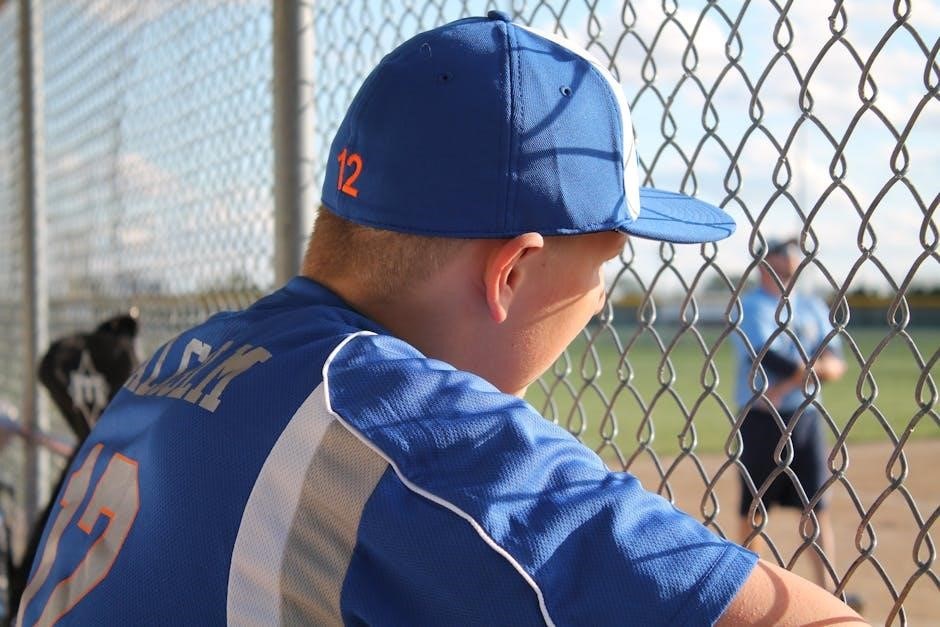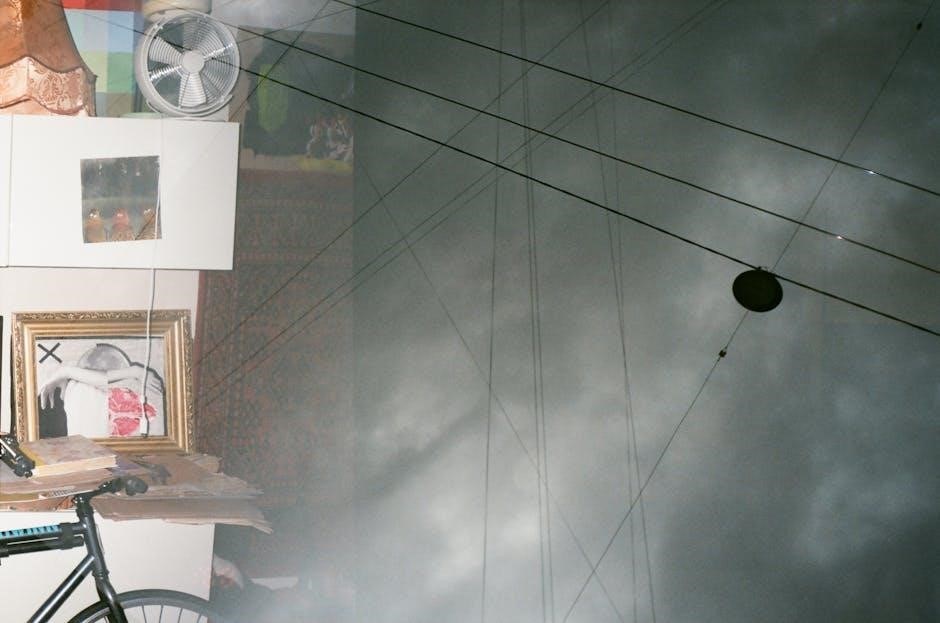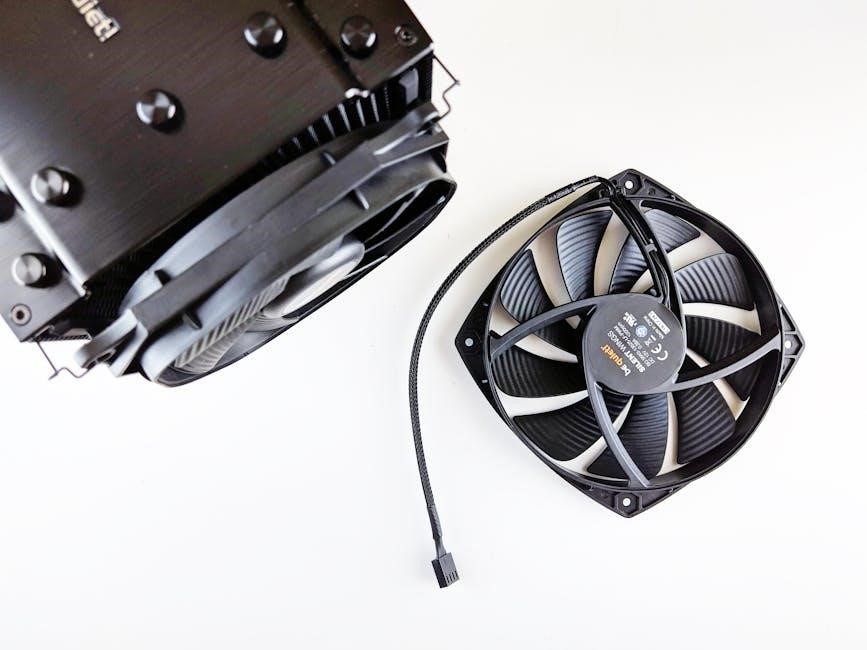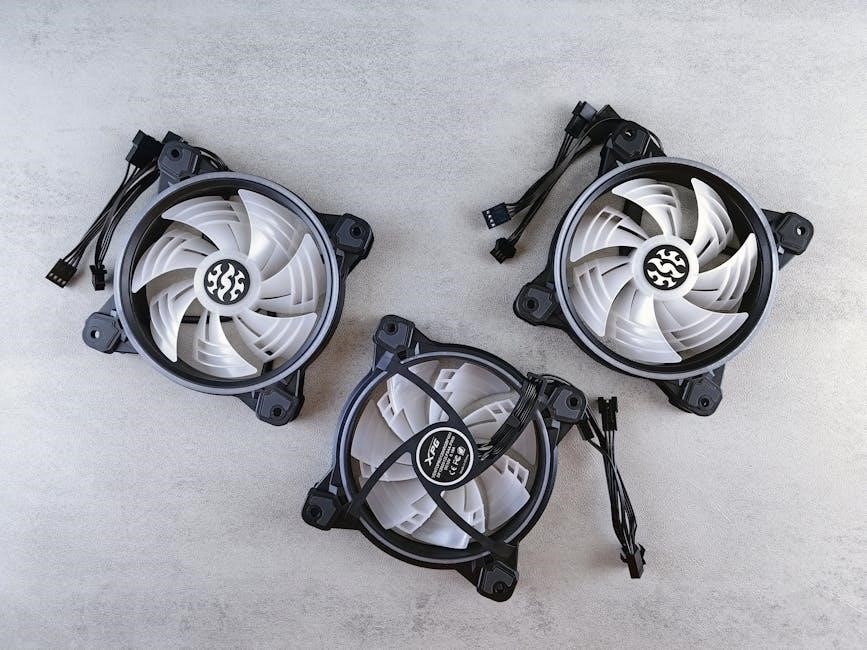
Proper wiring is essential for the safe and efficient operation of Manrose extractor fans, ensuring reliable performance and compliance with electrical regulations․
1․1 Overview of Manrose Extractor Fans
Manrose extractor fans are designed for efficient ventilation, offering models suited for bathrooms, kitchens, and other areas requiring airflow control․ Known for quiet operation and durability, these fans feature axial designs for easy installation and minimal noise․ Various models include pullcord, timer, and humidity-controlled options, catering to different needs․ Their compact designs and energy-efficient performance make them a popular choice for maintaining indoor air quality and preventing moisture buildup․ Manrose fans are available in multiple sizes, ensuring compatibility with various ducting systems and installation requirements․
- Energy-efficient and quiet operation․
- Compact designs for versatile installation․
- Models with pullcord, timer, and humidity controls․
- Designed for bathrooms, kitchens, and general ventilation․
1․2 Importance of Proper Wiring
Proper wiring is crucial for the safe and efficient operation of Manrose extractor fans․ Incorrect wiring can lead to electrical hazards, such as short circuits or fires, and may result in poor ventilation, causing mold growth in bathrooms․ It ensures the fan operates efficiently, meeting voltage and power requirements to avoid overheating or malfunction․ Compliance with regulations like IEE standards is necessary to pass inspections and maintain legality․ Proper connections ensure reliability, preventing breakdowns and ensuring features like timers function correctly․ Additionally, correct wiring preserves the manufacturer’s warranty, avoiding potential voidance and costly repairs․
- Prevents electrical hazards and safety risks․
- Ensures efficient operation and proper ventilation․
- Maintains compliance with legal and safety regulations․
- Supports reliable performance and feature functionality․
- Preserves manufacturer warranty coverage․

Safety Precautions
Always disconnect the power supply before wiring to prevent shocks or electrical hazards․ Follow IEE regulations and ensure proper ventilation during installation for safe operation․
- Turn off power supply before starting work․
- Adhere to electrical safety codes․
- Ensure proper ventilation․
2․1 Turning Off the Power Supply
Ensure the power supply is completely turned off before starting any wiring work․ This prevents electrical shocks and ensures a safe working environment․ Use a double pole fused spur with a minimum 3mm contact separation for secure disconnection․ Always verify that the power is off using a voltage tester․ Never rely on circuit breakers alone, as they may not isolate all live wires․ Properly securing the power supply is critical to avoid accidents during installation․
- Switch off the main power supply․
- Verify with a voltage tester․
- Use a double pole fused spur for isolation․
2․2 Understanding Electrical Regulations
Manrose extractor fans must be installed in compliance with current I․E․E․ Regulations or local electrical standards․ Ensure all wiring meets these regulations to guarantee safety and efficiency․ The use of a double pole fused spur with a 3A fuse is mandatory for extractor fans, providing secure electrical connections․ Additionally, all wiring should be securely fixed, and the cable to the fan must be at least 1․0mm2 in section․ Adhering to these guidelines ensures the system operates safely and efficiently․ Always consult local regulations for specific requirements․
2․3 Vent Installation Safety
Ensure proper ventilation by installing external wall grilles when fitting fans through walls․ Mount fans high on walls or ceilings for optimal performance․ Avoid placing fans too close to cooktops in kitchens, maintaining a minimum distance of 2 meters․ Secure all ducting firmly to prevent leaks or damage․ Use appropriate fixings to support the fan’s weight and ensure stable operation․ Always follow manufacturer guidelines and safety standards to prevent hazards and ensure reliable performance․ Correct installation ensures safe and efficient airflow management in your space․

Understanding Wiring Components
Manrose extractor fans require secure connections to ensure safe and efficient operation․ Refer to the internal wiring label for correct connections, and use appropriate cables and components as specified․
3․1 Internal Wiring Label
The internal wiring label provides a clear diagram and instructions for connecting the fan’s electrical components․ It ensures compliance with safety standards and manufacturer guidelines, making installation straightforward․
3․2 Key Wiring Components
The key wiring components include a double pole fused spur with a 3A fuse, ensuring safe electrical connections․ A minimum 1․0mm² to 1․5mm² cable is required for the fan․ Secure all wires to prevent damage, and use appropriate connectors for reliable connections․ Always ensure compliance with local electrical regulations and manufacturer guidelines for safety and efficiency․ Refer to the wiring label for specific component locations and connections to avoid installation errors․
Choosing the Right Location
Install the fan high on the wall or ceiling for optimal airflow․ Avoid locations near cooktops or where it may obstruct vents or windows․ Pullcord models are not suitable for ceiling installation․
4․1 Ideal Locations for Installation
The ideal location for installing a Manrose extractor fan is high on the wall or ceiling to maximize airflow efficiency․ For kitchens, ensure the fan is at least 2 meters away from cooktops to prevent grease accumulation․ In bathrooms, positioning the fan near the shower or bathtub area helps effectively remove moisture․ External wall installations require a grille to protect against weather conditions․ Always follow the manufacturer’s guidelines for optimal performance and safety․
4․2 Avoiding Inadequate Locations
Manrose extractor fans should not be installed in areas that hinder performance or safety․ Avoid positioning pullcord models in ceilings, as they are not suitable․ Do not install fans near flammable materials or in poorly ventilated spaces․ In kitchens, keep fans at least 2 meters away from cooktops to avoid grease buildup․ Ensure fans are not obstructed by nearby objects and avoid areas prone to excessive moisture or humidity that could damage electrical components․ Proper placement ensures efficient operation and longevity of the fan․

Tools and Materials Needed
Essential tools include a drill, screwdrivers, and pliers․ Required materials are screws, ducting, and a double-pole fused spur for safe electrical connections․ Proper preparation ensures efficient installation․
5․1 Essential Tools
Key tools needed for Manrose extractor fan installation include a power drill for making holes, screwdrivers for securing components, and pliers for gripping wires․ Additionally, a ladder is necessary for reaching high installation points, and cable ties are useful for organizing wiring․ A spirit level ensures proper alignment, while a tape measure helps in marking accurate positions․ Safety gear like gloves and goggles should also be on hand to protect against accidents during the process․
5․2 Required Materials
Essential materials include 1․0mm² to 1․5mm² copper cable for secure connections, a double pole fused spur with a 3A fuse, and cable clips for tidy installation․ Additionally, wall plugs and screws are needed for mounting the fan, while ducting and external grilles ensure proper airflow․ A pullcord switch or light switch may be required, depending on the fan model․ Adherence to these material specifications ensures compliance with safety standards and optimal fan performance, as outlined in the wiring instructions․
Electrical Supply Requirements
Manrose extractor fans require a 220-240V, 50Hz electrical supply, connected via a double pole fused spur with a 3A fuse, ensuring compliance with I;E․E․ regulations․
6․1 Voltage and Power Requirements
Manrose extractor fans operate on a 220-240V AC supply with a frequency of 50Hz, requiring minimal power consumption for efficient functionality․ The wiring must support this voltage range to ensure optimal performance and safety․ Always confirm the fan’s power requirements before installation to avoid electrical issues․ Proper voltage supply is crucial for maintaining the fan’s efficiency and extending its lifespan, while adhering to local electrical standards and regulations․ This ensures reliable operation in various settings, including bathrooms and kitchens․
6․2 Fuse Ratings and Circuit
A double pole fused spur with a 3mm contact separation in all poles is required for Manrose extractor fans, fitted with a 3A fuse․ The wiring must be securely fixed, using a cable of at least 1mm² in section․ This setup ensures safe and efficient operation, complying with electrical regulations․ Always use a qualified electrician to install the circuit, guaranteeing adherence to safety standards and preventing potential hazards․ Proper fuse ratings and circuit configurations are vital for reliable performance and long-term durability of the extractor fan system․
Wiring the Fan
Manrose extractor fans can be wired to a pullcord switch, light switch, or integrated with timers and humidity controls for automated operation, ensuring convenience and efficiency․
7․1 Connecting to a Pullcord Switch
Connect the Manrose extractor fan to a pullcord switch for manual operation․ Ensure the fan’s wiring matches the switch’s terminals․ Secure the connections and test the switch to confirm proper functionality․ Always follow the wiring diagram provided in the manual to avoid errors and ensure safety․ This setup allows easy control, making it ideal for bathrooms and kitchens where manual operation is preferred; Verify all connections are secure and comply with electrical regulations before use․
7․2 Integrating with a Light Switch
Connect the Manrose extractor fan to a light switch for synchronized operation․ Wire the fan so it activates when the light is turned on․ Ensure the live and neutral wires are correctly connected to the switch․ This setup eliminates the need for a separate switch, simplifying control․ Refer to the internal wiring label for proper connections․ Always comply with electrical regulations and test the circuit after wiring to ensure functionality and safety․ This integration is ideal for coordinating ventilation with lighting in bathrooms or kitchens․
7․3 Timer and Humidity Controls
Manrose extractor fans can be equipped with timer and humidity controls for advanced operation․ The timer allows setting a specific runtime, ensuring efficient ventilation․ Humidity controls activate the fan when moisture levels rise, preventing mold growth․ For humidity operation, a permanent live and neutral supply is required, connected via a fused spur unit․ The fan will run until humidity drops 5% below the set level․ Always refer to the wiring diagram for correct connections and ensure compliance with electrical standards to avoid malfunctions․ Proper setup ensures optimal performance and energy efficiency․

Ducting Installation
Ensure proper ducting installation by fitting an external grille when installing through walls and securing all ducting connections tightly to prevent air leaks and maintain efficiency․
8․1 Ducting Requirements
Use ducting of the correct size and material to ensure efficient airflow․ For wall installations, fit an external grille and avoid flexible hoses for fixed wiring models․ Ensure all ducting connections are secure and airtight to prevent leaks․ Keep duct runs as short as possible to maintain performance․ Flexible ducting should only be used for window fan models, with internal cord anchorage provided․ Proper ducting installation is crucial for optimal fan operation and energy efficiency․
8․2 Securing the Ducting
Secure the ducting with approved clips or brackets to prevent movement or sagging․ Ensure all connections are airtight to maintain optimal airflow․ For wall installations, external grilles must be fitted when ducting is routed through external walls․ Avoid using flexible hoses for fixed wiring models, as they may compromise performance․ Properly securing the ducting ensures efficient operation and prevents damage to the fan or ducting system over time․ Always follow the manufacturer’s guidelines for securing methods to guarantee safety and reliability․ Regular inspections are recommended to maintain integrity․
Adjusting Timer and Humidity Controls
Adjust the timer to set operation duration and humidity levels to automate the fan, ensuring efficient ventilation management without constant manual intervention․
9․1 Setting the Timer
Setting the timer on your Manrose extractor fan allows you to automate its operation․ Locate the timer dial or digital interface, depending on your model․ Rotate the dial to set the desired duration, typically ranging from 5 to 30 minutes․ For digital models, use the control panel to input the time․ Ensure the timer is set according to your ventilation needs․ Once activated, the fan will run for the set period before shutting off automatically․ This feature enhances convenience and energy efficiency, ensuring proper ventilation without manual oversight․ Always refer to your specific model’s instructions for precise guidance, as interfaces may vary․ Proper timer setup is crucial for maintaining optimal performance and compliance with safety standards․ Additionally, consider factors like humidity levels and room size when determining the timer duration․ This ensures the fan operates efficiently, removing moisture and airborne contaminants effectively․ Regularly review and adjust the timer as needed to accommodate changing conditions or personal preferences․ By following these steps, you can maximize the functionality of your extractor fan and maintain a healthy indoor environment․ Remember to test the timer after installation to ensure it operates correctly․ If issues arise, consult the troubleshooting section for solutions․ Proper timer functionality is essential for the overall performance of your Manrose extractor fan, contributing to improved air quality and reduced energy consumption․ Always prioritize accurate timer settings for optimal results․
9․2 Adjusting Humidity Levels
Adjusting humidity levels ensures your Manrose extractor fan operates efficiently․ Set the desired humidity threshold using the control dial or digital interface․ The fan activates when humidity exceeds this level and turns off once it drops by 5%․ This feature optimizes ventilation and prevents over-drying of the air․ For accurate adjustment, refer to your model’s instructions, as controls may vary․ Proper humidity calibration enhances energy efficiency and maintains a comfortable environment․ Ensure the settings align with your space’s specific needs for optimal performance․ This adjustment is typically done during installation but can be fine-tuned later․ Always use a remote switch or fused spur unit for humidity-controlled models to ensure safe operation․ Regularly check and adjust the settings to maintain desired humidity levels, especially in areas prone to moisture fluctuations․ This feature is particularly beneficial in bathrooms and kitchens, where humidity levels can vary significantly․ By customizing the humidity settings, you can ensure the fan runs only when necessary, reducing energy consumption and prolonging its lifespan․ Proper adjustment also helps in preventing mold growth and maintaining indoor air quality․ For best results, consult your specific model’s guidelines for precise calibration instructions․ This ensures the fan operates seamlessly with your home’s unique conditions․ Adjusting humidity levels is a straightforward process that significantly impacts the fan’s performance and energy efficiency․ Make sure to test the settings after adjustment to confirm they work as intended․ If the fan doesn’t respond correctly, check the connections and ensure the humidity sensor is clean and free from obstructions․ Regular maintenance of the sensor is crucial for accurate readings and reliable operation․ By following these steps, you can maximize the benefits of your Manrose extractor fan and enjoy a healthier, more comfortable living space․ Adjusting humidity levels is a key feature that sets these fans apart, providing intelligent ventilation solutions for modern homes․ Always prioritize proper calibration for optimal results․

IP Rating Considerations
Manrose extractor fans must be installed in locations suitable for their IP rating, ensuring protection against moisture and dust․ Always select models with appropriate IP ratings for safe operation․
10;1 Understanding IP Ratings
IP ratings define the level of protection an electrical device has against solids and liquids․ For Manrose extractor fans, the rating determines suitable installation locations․ The first digit indicates protection against solids, while the second digit indicates protection against moisture․ For example, IP44 means protection against solid particles up to 1mm and splashing water․ Higher ratings like IP45 offer better protection․ Always choose a fan with an IP rating appropriate for its intended location to ensure safety and compliance with electrical standards․ This ensures optimal performance and longevity․
10․2 Ensuring Compliance
Ensuring compliance with electrical regulations is crucial for safe and effective installation․ Manrose extractor fans must be installed by a qualified electrician, adhering to IEE standards․ Use a double pole fused spur with a 3mm contact separation and a 3A fuse․ All wiring must be securely fixed, with cables sized between 1․0mm² and 1․5mm²․ Compliance also involves proper IP rating selection for the fan’s location, such as IP44 for areas exposed to splashing water․ Always follow manufacturer guidelines to meet safety and efficiency standards, ensuring reliable operation and longevity of the fan․

Testing the Fan
Testing involves checking the fan’s operation immediately after installation and ensuring it runs smoothly, with proper airflow and minimal noise, indicating successful setup and functionality․
11․1 Initial Testing
Initial testing ensures the fan operates correctly after installation․ Switch on the power supply and check for smooth rotation, airflow, and minimal noise․ Verify all controls, such as pullcord or light switch integration, function as intended․ Ensure shutters open and close fully on auto models․ Confirm the fan starts and stops as expected, with no unusual vibrations or sounds․ This step confirms proper wiring and installation, ensuring safety and efficiency before regular use begins․
11․2 Post-Installation Check
After installation, inspect all connections for security and ensure no wiring is loose․ Verify that the fan and ducting are properly aligned and sealed to prevent air leaks․ Check that the grille is securely fitted and that all moving parts function smoothly․ Test the fan under normal operating conditions to confirm airflow efficiency and noise levels․ Ensure compliance with safety standards and manufacturer guidelines, addressing any issues promptly to maintain optimal performance and longevity of the extractor fan system․

Troubleshooting Common Issues
Common issues include faulty wiring connections, motor overheating, or the fan not operating․ Check for blockages, ensure proper ducting alignment, and verify power supply stability for resolution․
12․1 Identifying Wiring Problems
Identifying wiring issues begins with checking connections for loose wires or corrosion․ Ensure the fan’s internal wiring label is followed accurately․ Verify that the power supply matches the fan’s voltage requirements, typically 220-240V, 50Hz․ Check for any damage to cables or connectors․ If the fan doesn’t start, inspect the pullcord switch or light switch connections․ Ensure all wiring complies with I․E․E․ regulations and that the double pole fused spur with a 3A fuse is correctly installed․ Consult the manufacturer’s guidelines if issues persist․
12․2 Resolving Common Faults
Common faults like the fan not turning on can often be resolved by checking the power supply and ensuring the fused spur is functional․ If the fan operates intermittently, inspect the wiring for loose connections or damage; For models with timers or humidity controls, verify that settings are correctly adjusted․ In cases where the fan does not shut off, check the switch or control mechanisms․ Always refer to the internal wiring label and ensure compliance with electrical regulations․ Consulting the manufacturer’s instructions or a qualified electrician can help resolve persistent issues efficiently․

Maintenance Tips
Regularly clean the fan and ducting to ensure optimal airflow and efficiency․ Check electrical connections for tightness and inspect for wear or damage to prevent faults․
13․1 Regular Cleaning
Regular cleaning ensures optimal airflow and efficiency․ Start by turning off the power supply․ Gently remove and clean the grille and filters using a soft cloth or brush to eliminate dust buildup․ For tougher grime, a mild detergent solution can be used, but avoid harsh chemicals․ Wipe the fan blades and interior with a damp cloth, ensuring no moisture enters electrical components․ Clean the ducting and vents to remove debris, which can obstruct airflow․ Avoid using vacuum cleaners, as they may damage internal parts․ Regular maintenance prevents dust accumulation and ensures smooth operation․ Also, clean the exterior casing to maintain appearance․
13․2 Checking Connections
Regularly inspect all wiring connections to ensure they are secure and free from damage․ Turn off the power supply before checking․ Verify that all terminals are tightly screwed and not loose․ Look for signs of wear or fraying in the cables, which may indicate a need for replacement․ Check the fuse ratings and circuit connections to ensure they match the fan’s specifications․ Properly secured connections prevent electrical hazards and ensure the extractor fan operates efficiently․ This step is crucial for maintaining safety and performance over time․

Manufacturer’s Warranty
Manrose extractor fans come with a manufacturer’s warranty covering parts and labor for a specified period․ Proper installation and adherence to instructions are essential for warranty validity․
14․1 Warranty Details
Manrose extractor fans are backed by a manufacturer’s warranty, typically covering parts and labor for a specified period․ This warranty ensures protection against defects in materials and workmanship․ Proper installation, adherence to wiring instructions, and regular maintenance are essential to maintain warranty validity․ The warranty period varies by model but generally ranges from 1 to 5 years․ It is designed to provide peace of mind, ensuring your investment is protected․ Always refer to the product manual or manufacturer’s website for precise warranty terms and conditions․
14․2 Conditions and Exclusions
The warranty does not cover damage caused by misuse, incorrect installation, or unauthorized modifications․ Proper wiring and adherence to installation instructions are essential to maintain coverage․ Regular maintenance, as outlined in the manual, is required to uphold warranty terms․ Damage from external factors, such as power surges or environmental conditions, may also be excluded․ Always follow the manufacturer’s guidelines to ensure warranty validity and avoid potential exclusions․ Refer to the product manual for a comprehensive list of conditions and exclusions․
Proper installation and wiring ensure efficient and safe operation․ Compliance with regulations and manufacturer guidelines is crucial․ Follow instructions for reliable performance and longevity․
15․1 Summary of Key Points
Manrose extractor fan wiring requires adherence to safety guidelines and electrical regulations․ Correct connections, secure ducting, and proper power supply ensure optimal performance․ Always follow manufacturer instructions for installation and wiring․ Regular maintenance and compliance with IP ratings are vital for longevity․ Ensure all components are securely fixed, and wiring meets local standards․ Professional installation by a qualified electrician is recommended to avoid faults and ensure compliance with safety regulations․
15․2 Final Tips for Success
Always refer to the internal wiring label and manufacturer’s guidelines for precise connections․ Use the correct tools and materials to ensure secure installations․ Regularly inspect and clean the fan to maintain efficiency․ Properly set timers and humidity controls for optimal performance․ Ensure all electrical connections comply with local regulations․ If unsure, consult a qualified electrician to avoid potential hazards․ By following these steps, you can achieve a safe, efficient, and long-lasting extractor fan system․
Additional Resources
Visit the official Manrose website for detailed manuals and guides․ Check authorized retailers for specific product instructions․ Consult online forums for troubleshooting tips and expert advice․
16․1 Manufacturer’s Guidelines
Always refer to the official Manrose installation manuals for specific wiring instructions․ These guides provide detailed diagrams and step-by-step procedures for various models, such as the 100T or Quiet Fan Series․ Ensure compliance with safety standards like IEE Regulations or local codes․ Manufacturer guidelines emphasize proper wiring techniques, such as using a double pole fused spur and minimum cable sizes․ They also outline IP rating requirements for different installation environments․ Adhering to these guidelines ensures safe and efficient fan operation․ Consult the manual for model-specific instructions before starting any wiring project․
16․2 Further Reading
For additional insights, visit the official Manrose website for detailed product guides and wiring diagrams․ Explore DIY forums and electrical resources for supplementary installation tips․ Refer to model-specific manuals, such as the Manrose 100T or Quiet Fan Series, for advanced wiring configurations․ Websites like YouTube and electrical advice platforms offer video tutorials and troubleshooting guides․ These resources are invaluable for mastering Manrose extractor fan wiring and ensuring optimal performance․ They cater to both novices and experienced installers, providing comprehensive support for a successful setup․
